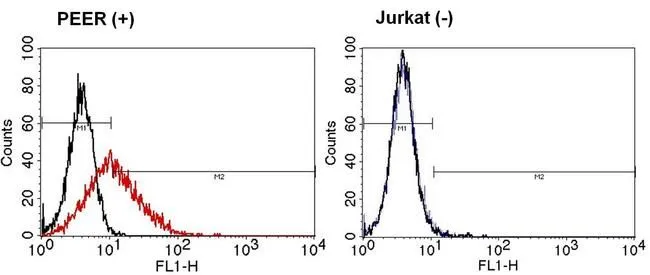
GTX15594 FACS Image
TCR gamma + delta antibody [5A6.E9] - Orthogonal Validated

GTX15594
ApplicationsFlow Cytometry, ImmunoPrecipitation, ELISA, ImmunoHistoChemistry, ImmunoHistoChemistry Frozen, ImmunoHistoChemistry Paraffin, Neutralisation/Blocking, Other Application
Product group Antibodies
ReactivityHuman, Primate
Overview
- SupplierGeneTex
- Product NameTCR gamma + delta antibody [5A6.E9] - Orthogonal Validated
- Delivery Days Customer10
- ApplicationsFlow Cytometry, ImmunoPrecipitation, ELISA, ImmunoHistoChemistry, ImmunoHistoChemistry Frozen, ImmunoHistoChemistry Paraffin, Neutralisation/Blocking, Other Application
- CertificationResearch Use Only
- ClonalityMonoclonal
- Clone ID5A6.E9
- Concentration0.15 mg/ml
- HostMouse
- IsotypeIgG
- Scientific DescriptionT cell receptors recognize foreign antigens which have been processed as small peptides and bound to major histocompatibility complex (MHC) molecules at the surface of antigen presenting cells (APC). Each T cell receptor is a dimer consisting of one alpha and one beta chain or one delta and one gamma chain. In a single cell, the T cell receptor loci are rearranged and expressed in the order delta, gamma, beta, and alpha. If both delta and gamma rearrangements produce functional chains, the cell expresses delta and gamma. If not, the cell proceeds to rearrange the beta and alpha loci. This region represents the germline organization of the T cell receptor gamma locus. The gamma locus includes V (variable), J (joining), and C (constant) segments. During T cell development, the gamma chain is synthesized by a recombination event at the DNA level joining a V segment with a J segment; the C segment is later joined by splicing at the RNA level. Recombination of many different V segments with several J segments provides a wide range of antigen recognition. Additional diversity is attained by junctional diversity, resulting from the random addition of nucleotides by terminal deoxynucleotidyltransferase. Several V segments of the gamma locus are known to be incapable of encoding a protein and are considered pseudogenes. Somatic rearrangement of the gamma locus has been observed in T cells derived from patients with T cell leukemia and ataxia telangiectasia. [provided by RefSeq]
- ReactivityHuman, Primate
- Storage Instruction2°C to 8°C,-20°C
- UNSPSC12352203
References
- Distribution and functions of gammadelta T cells infiltrated in the ovarian cancer microenvironment. Chen X et al., 2019 May 7, J Transl MedRead more
